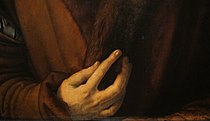Self-Portrait (Dürer)
| Self-Portrait | |
|---|---|
 |
|
| Artist | Albrecht Dürer |
| Year | 1500 |
| Medium | Oil on wood panel |
| Dimensions | 66.3 cm × 49 cm (26.1 in × 19 in) |
| Location | Alte Pinakothek, Munich |
 |
|
|
|
Self-Portrait (or Self-Portrait at Twenty-Eight Years Old Wearing a Coat with Fur Collar) is a painting on wood panel by the German Renaissance artist Albrecht Dürer. Painted early in 1500, just before his 29th birthday, it is the last of his three painted self-portraits. It is considered the most personal, iconic and complex of his self-portraits, and the one that has become fixed in the popular imagination.
The self-portrait is most remarkable because of its resemblance to many earlier representations of Christ. Art historians note the similarities with the conventions of religious painting, including its symmetry, dark tones and the manner in which the artist directly confronts the viewer and raises his hands to the middle of his chest as if in the act of blessing.
In its directness and apparent confrontation with the viewer, the self-portrait is unlike any that came before. It is half-length, frontal and highly symmetrical; its lack of a conventional background seemingly presents Dürer without regard to time or place. The placement of the inscriptions in the dark fields on either side of Dürer are presented as if floating in space, emphasizing that the portrait has a highly symbolic meaning. Its sombre mood is achieved through the use of brown tones set against the plain black background. The lightness of touch and tone seen in his earlier two self-portraits has been replaced by a far more introverted and complex representation. In this work, Dürer's style seems to have developed into what art historian Marcel Brion described as "a classicism like that of Ingres. The face has the inflexibility and impersonal dignity of a mask, hiding the restless turmoil of anguish and passion within."
Geometric analysis of the composition demonstrates its relatively rigid symmetry, with several highlights aligned very close to a vertical axis down the middle of the painting. However, the work is not completely symmetrical; his head is slightly right of centre, his hair not quite in the middle——the strands of hair fall differently on either side while his eyes look slightly to the left.
In 1500 a frontal pose was exceptional for a secular portrait; in Italy the conventional fashion for profile portraits was coming to an end, but being replaced with the three-quarters view which had been the accepted pose in Northern Europe since about 1420, and which Dürer used in his earlier self-portraits. Fully frontal poses remained unusual, although Hans Holbein painted several of Henry VIII of England and his queens, perhaps under instruction to use the pose. Late medieval and Early Renaissance art had developed the more difficult three-quarters view, and artists were proud of their skill in using it; to viewers in 1500 and after, a frontal pose was associated with images from medieval religious art, and above all images of Christ.
...
Wikipedia
